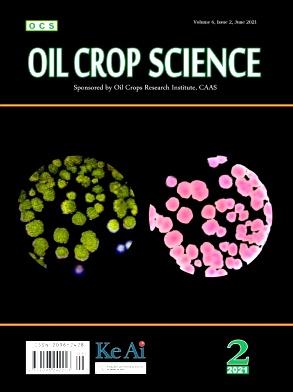利用木霉改良油菜籽作物:基因转移与直接互作
Q3 Agricultural and Biological Sciences
引用次数: 0
摘要
全球农业必须紧急采取一种新办法,确保在当前不利条件下为不断增加的人口生产足够的粮食,同时优先考虑环境的可持续性。这种变化需要创新和环保的方法,例如基于共生微生物的产品。在这些生物中,木霉属尤为突出,因为这些真菌内生菌存在于许多植物物种中,包括芸苔科植物,并与它们积极相互作用。芸苔科包括许多具有特殊农业和食品价值的分类群,例如油籽芸苔科(OSBs)。在这类作物中,有获得油菜籽和芥菜籽的作物,它们分别常用来生产油脂和香料。osb是一种富含维生素和矿物质的食品,具有抗菌、抗氧化和抗肿瘤的潜在应用价值。因此,这些植物物种(或其栽培方法)的改进可能最终导致人类食物的改善,从而改善人类健康。这一进展可以与木霉真菌属齐头并进,要么是基于对它们的一些基因进行转基因,要么是利用这些真菌来配制和生产生物接种剂。在转基因方面,研究最广泛的是那些基于木霉基因编码几丁质酶和kelch样家族蛋白的转基因,在这两种情况下都能达到对致病真菌的抗真菌作用。关于以木霉为基础的产品,这些产品的目的可以是促进植物生长,通过作为生物防治剂(bca)保护作物免受病原体侵害,甚至减少土壤中的污染物,如重金属。本文献综述的目的是分析和讨论迄今为止大多数关于OSB作物与木霉真菌相互作用的现有研究。本文章由计算机程序翻译,如有差异,请以英文原文为准。

Improvement of oilseed Brassica crops by Trichoderma use: Gene transfer and direct interaction
Global agriculture must urgently adopt a new approach to ensure adequate food production for the increasing population in the current context of adverse conditions, while prioritizing environmental sustainability. This change requires innovative and environmentally conscious methods, such as symbiotic-microorganisms-based products. Among these organisms, the genus Trichoderma stands out, as these fungal endophytes reside within many plant species including those in the Brassicaceae family and interact with them positively. Brassicaceae encompass numerous taxa of special agricultural and food interest, such as those known as oilseed brassicas (OSBs). Among these group are crops for obtaining canola and mustard seeds, commonly used for oil and spices production, respectively. OSBs are of greater interest for food because they are rich source of vitamins and minerals, and have also a great antimicrobial, antioxidant and antitumor potential application. Therefore, the improvement of these plant species (or of their cultivation methods) may ultimately lead to an improvement in human food and, accordingly, human health. This progress could go hand in hand with the Trichoderma fungal genus, either based on transgenesis with some of their genes, or using these fungi to formulate and produce bioinoculants. In relation to transgenesis, the most widely studied are those based on Trichoderma genes encoding endochitinases and Kelch-like family proteins, in both cases to achieve an antifungal effect against pathogenic fungi. With regard to Trichoderma-based products, these can be aimed at promoting plant growth, protecting crops against pathogens by acting as biological control agents (BCAs), or even reducing contaminants in the soil, such as heavy metals. The purpose of the present literature review is to analyse and discuss most of the existing studies to date on the interaction between OSB crops and Trichoderma fungi.
求助全文
通过发布文献求助,成功后即可免费获取论文全文。
去求助
来源期刊

Oil Crop Science
Food Science, Plant Science, Agronomy and Crop Science
CiteScore
3.40
自引率
0.00%
发文量
20
审稿时长
74 days
 求助内容:
求助内容: 应助结果提醒方式:
应助结果提醒方式:


